Picture Prompts – Creating Art Journal Pages with Hand-Drawn Animals
This week, we use small collage pieces as picture prompts for art journal pages.
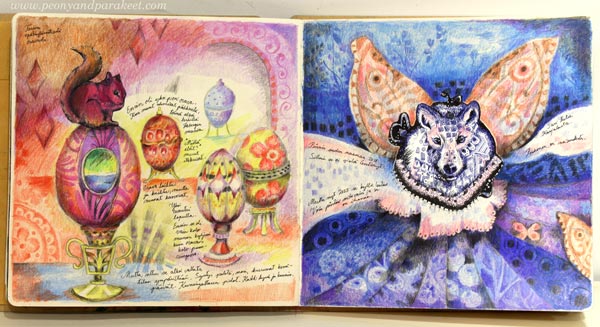
First you pick a small image, a hand-drawn squirrel or wolf in my case, and use that as inspiration for the rest of the page. You will need paper, colored pencils, and a pen for journaling. I also used felt-tip pens for the details that I wanted to highlight and graphite pencils for quick sketching. I attached the animals to the page with double-sided tape. My journal is Dylusions Creative Journal Square. (Affiliate link to Amazon.com).
Open Your Box of Joy and Select the Animal!
We will use hand-drawn animals as picture prompts. You can, of course, use any image, but I suggest starting with animals.
I save my hand-drawn collage pieces in boxes that I call boxes of joy. These little drawings are born from the joy of drawing. I have cut them so that they can be used as collage pieces.
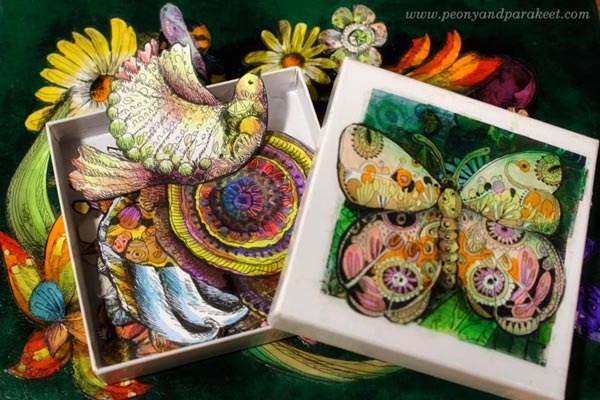
I started drawing these small separate little things in 2018, and have been creating them ever since. It’s so easy to pick a paper scrap and draw something simple, and then get enthusiastic about adding decorations and colors to it. I have several online courses where we draw these: Animal Inkdom, Magical Inkdom, Decodashery, and Doll World.
My animals are mostly drawn for the courses Animal Inkdom and Magical Inkdom, and I love them so much, that I have also printed copies of some of them. I have many boxes to choose from and I love to both use them and re-fill them.
For the first page, I selected a squirrel because it has pink and orange, and those have been my favorite colors recently.
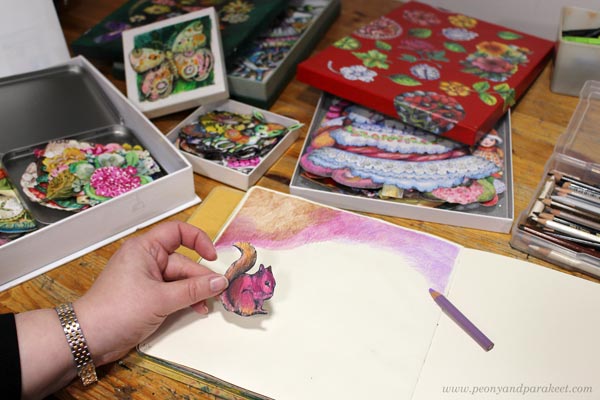
After selecting the animal, use its colors to color a small part of the page! Just color some layers freely (like in the course Intuitive Coloring). Don’t glue the animal yet, wait until you draw more and the story unfolds.
Picture Prompts – Go Beyond the Obvious!
We have a big nut bush in our garden and squirrels love it. So, my first thought was to draw some nuts for the squirrel. But that would be too ordinary and not fun at all. What if this squirrel would chase after Faberge eggs while others collect peanuts?
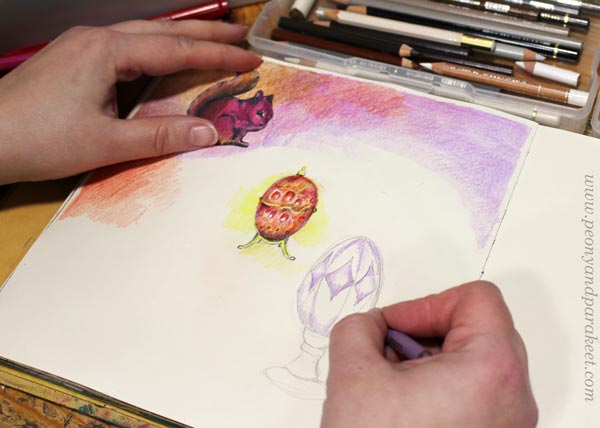
I love drawing decorated eggs. In Doll World, we draw a big egg, but this time I wanted the eggs to be small so I could fit many on one page.
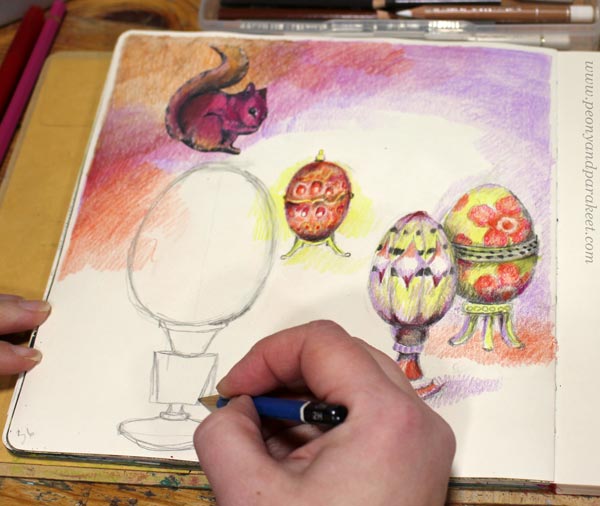
I made the eggs a bit different in size to make the page more interesting.
Static vs. “What If …”
When using the animal as a creative picture prompt, you want to find the story – not only the connection between the starting idea and the additions but also something surprising that keeps the inspiration going. If you only draw the ordinary, the picture easily becomes static – nothing is happening. Go for the extraordinary! Change the rules of reality, change the roles of the objects, make the animal speak – by drawing, you can create a world of your own. Ask: “What if?”
When I drew the first egg, it felt like just any object, but when I drew more of them, my imagination started working. Maybe the squirrel could sit on the biggest egg? And maybe the eggs could have a bigger role than to be just a decoration.

What if the scenery that I colored inside the biggest egg would leak into the surroundings?
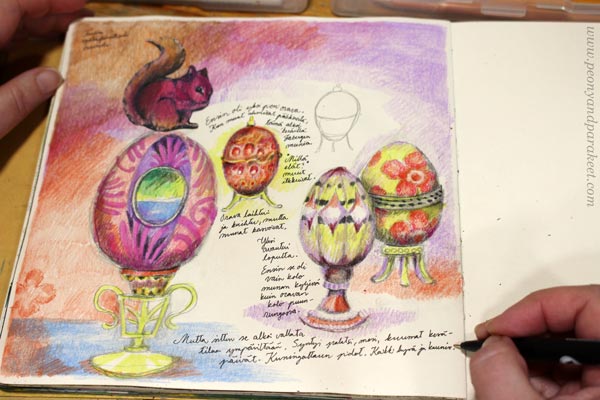
I wrote: “A palace was born, hot summer days came here, the queen (the squirrel) had a party, and all things good and beautiful came up.”
Then I drew more and completed the page inspired by the journaling.
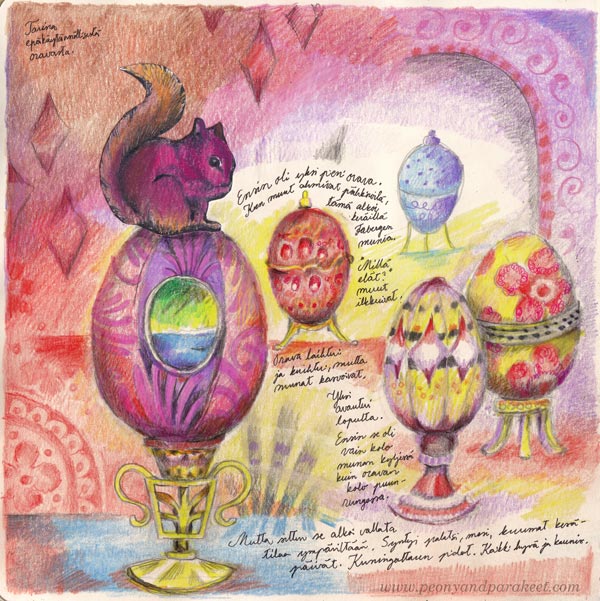
This is a story about an impractical squirrel who collected Faberge eggs instead of nuts and wasn’t much like other squirrels. But her eggs didn’t stay small. They grew and opened and created a place for her to live in.
“Isn’t that a story about every artist,” I realized after the page was finished.
Flying Wolf Art Journal Page
Let’s pick another animal and make the second page!
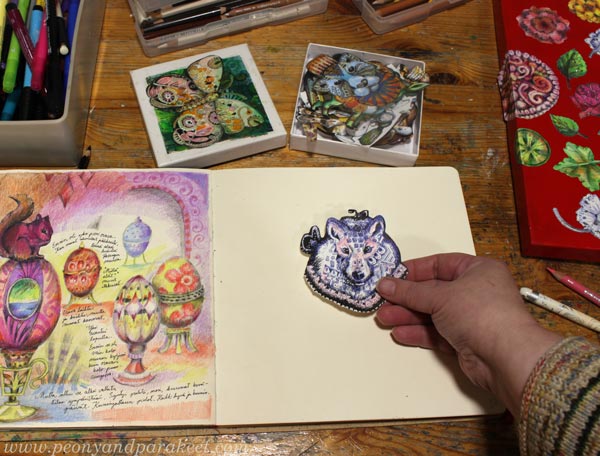
This wolf is the first little collage piece that I drew in 2018, so it’s time to give her a home. Decorating the animals was one of my core ideas for Animal Inkdom, so I can now color freely so that the decorations will continue to the background too.
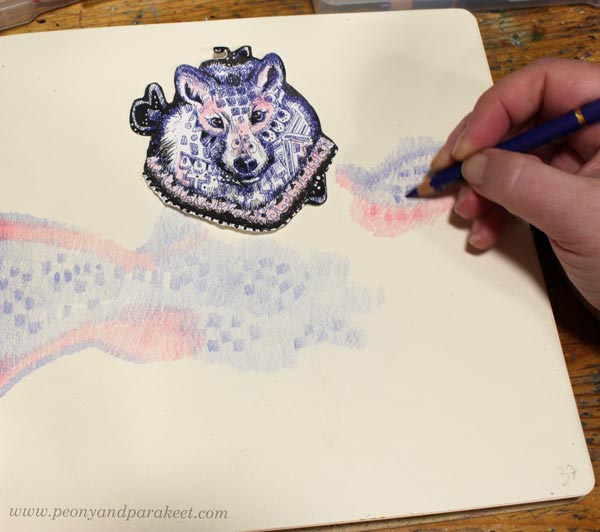
Again, I am using the colors that the animal has: blue, black, and pink. This way the collage piece doesn’t look separate from the rest of the page.
I wanted the wolf to fly, but not with furry wings. Could the wolf be partly a butterfly?
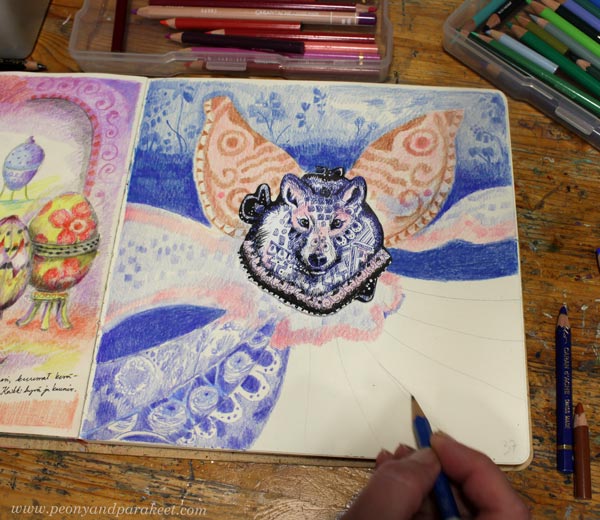
With the wolf, I felt a connection to my North Karelian origin. With the butterfly wings, I celebrated being a woman and loving delicate beautiful things.
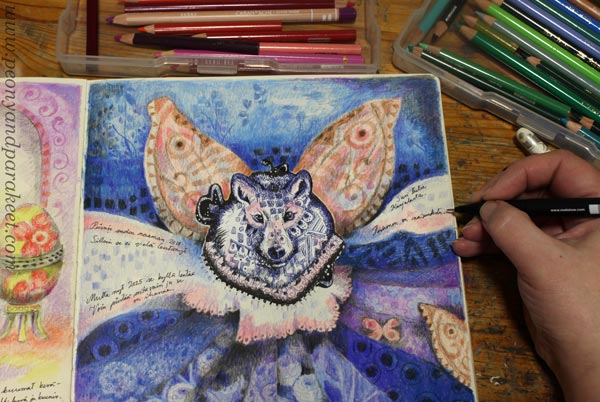
This wolf didn’t feel like a lonely one. So, I added a small butterfly and another bigger that is showing only partly on the right edge.
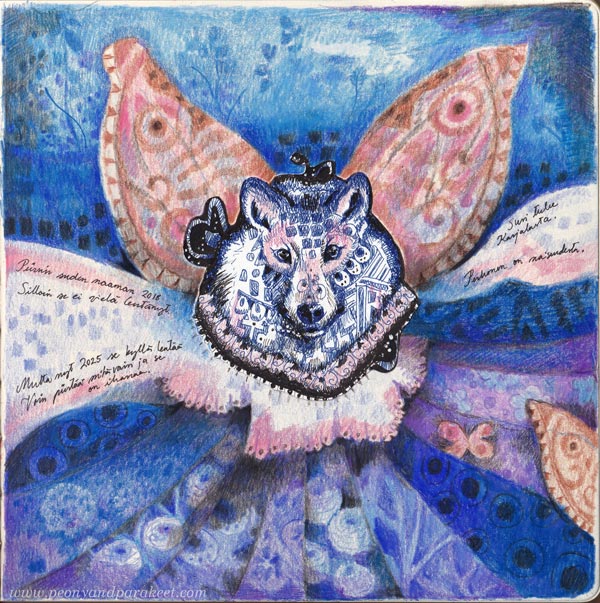
Back in 2018, my wolf didn’t fly yet, but it’s flying now! The more you draw, the more you can imagine!
Picture Prompts – Step by Step
- Pick the animal.
- Use the animal’s colors and patterns to get started.
- Ask: “What if …”
- Answer by drawing and journaling.
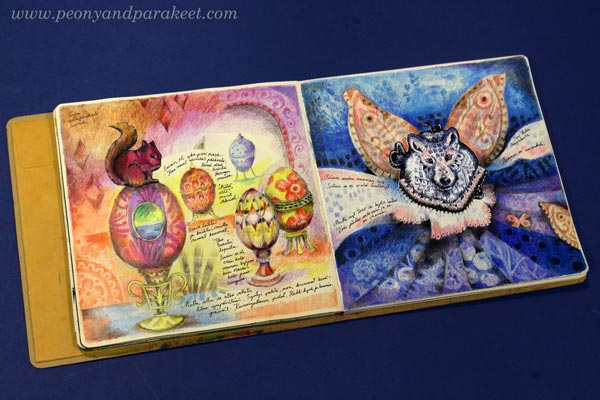
New in Development!
I have been making a new course that has a working title “Hearts and Stories.” I have already drawn quite many pieces for it. I collect them under a plastic plate that fits the side table of my studio. There I can see the whole collection at the same time, and think about what’s missing and how I will proceeed.
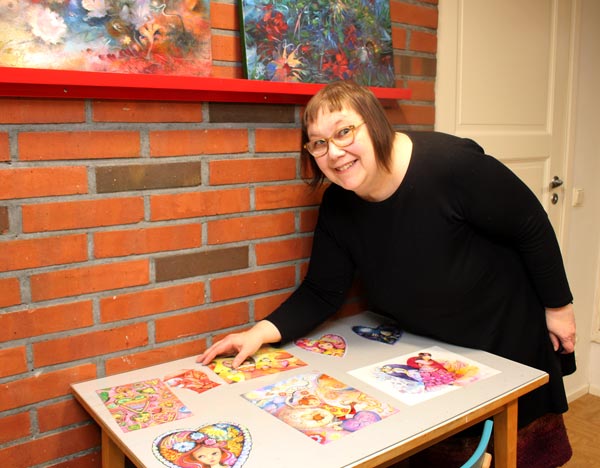
These drawings make me smile. My goal is that you too will smile when the course is running!
I want to be the advocate for drawing, because:
- If you only think, your imagination has limited capacity.
- If you only paint, you will stop playing and eventually run out of creative ideas.
- Drawing is important for any artist and for any human being.
What do you think?
Torn Paper Collage for Artistic Exploration
Torn paper collage – do you remember making them as a child?
This project is not so much about the resulting image, but about the process.
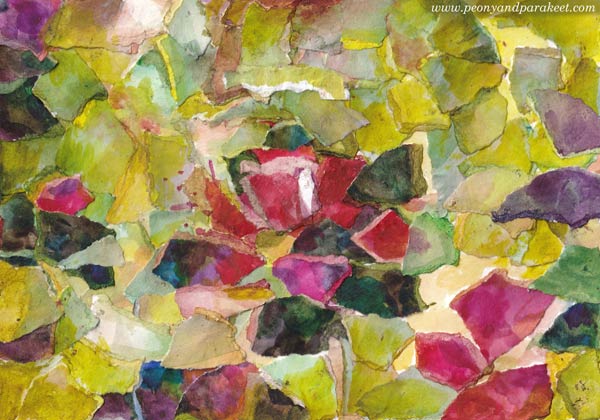
You will need watercolors, thick drawing paper, and paper glue.
I have used Fabriano Accademia Drawing Paper (200 gsm/94 lbs). It’s not as thick as most watercolor papers but holds water well and is nice for collages. I bought this paper for the course Joyful Coloring, and it has become one of my favorites because it’s so versatile.
Step 1 – Paint the Papers
One of the best ways to grow your artistic skills is to move away from ready-made images and make the material for collages yourself.
While creating, think about this!
There’s a hidden miracle in every brush stroke, even in the ugliest ones. The potential of them is huge. Your artistry grows when you keep creating.
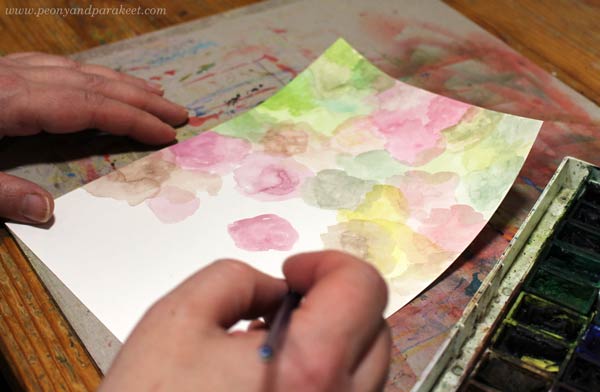
When you make the papers yourself, you can choose colors and add variation that will make every torn paper piece unique.
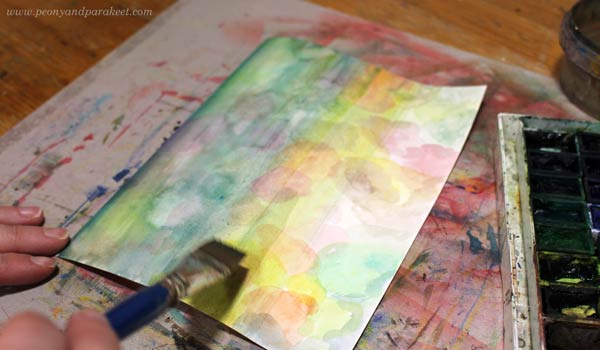
With watercolors, you easily achieve translucent effects and get great pastel tones. But also make a paper with darker and more vivid colors!
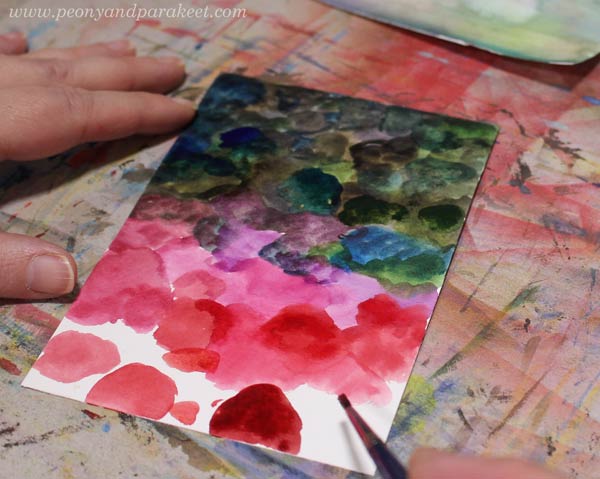
Check that you have all these variations: light, bright, and dark!
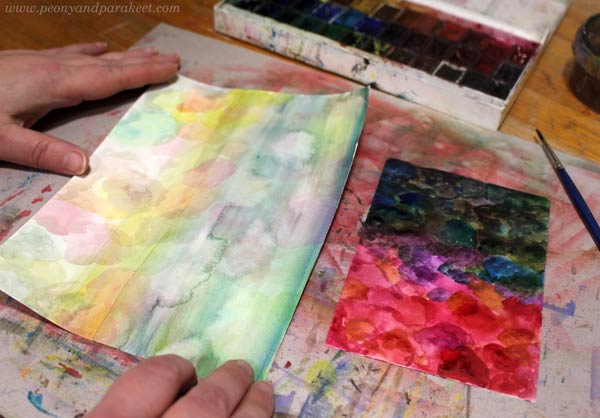
For a small collage, not so many papers are needed. My papers are 1,5 times the size of the final artwork.
Before continueing, think about this!
The papers are precious treasures. Handle them carefully like they would be glass!
Step 2 – Tore the Papers into Small Pieces
Next, let’s “break glass”! With fingers, tore the papers into pieces.
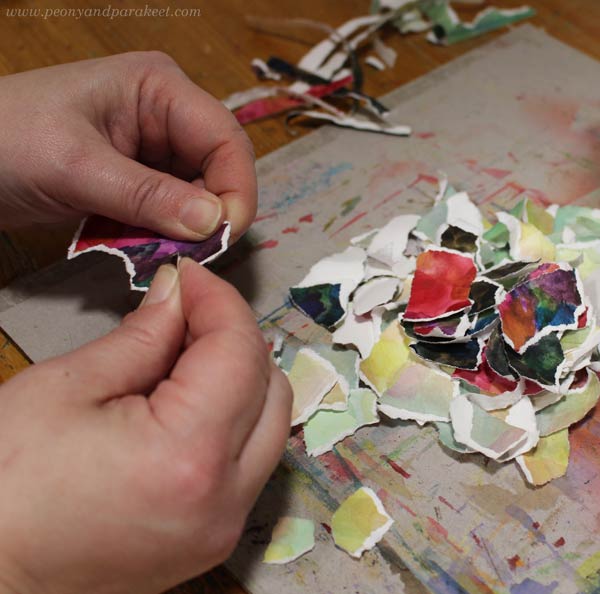
While creating, think about this!
Art is born, when you question what you see, experience, and own. While tearing the paper, let go of pre-assumptions of what you are going to create.
Step 3 – Paint the Torn Edges
The edges are the best part of torn paper collages, but especially when you paint them too. This way you don’t get too much distracting white to your collage, but the result will more colorful and atmospheric.
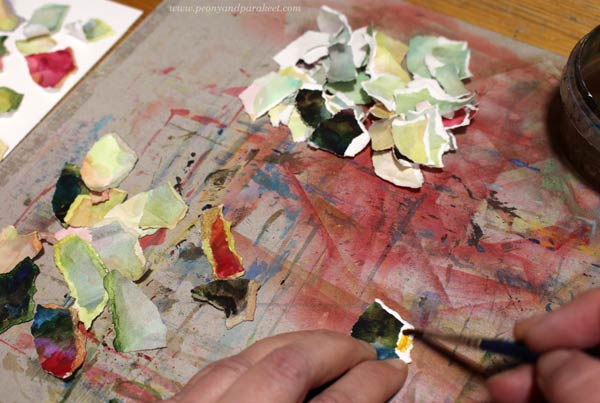
While creating, think about this!
Some people like to think a lot, some are more hands on. In artistic exploration, finding the balance is the key. This exercise is especially for thinkers. Look at the torn pieces – so many new beginnings, seeds for new ideas!
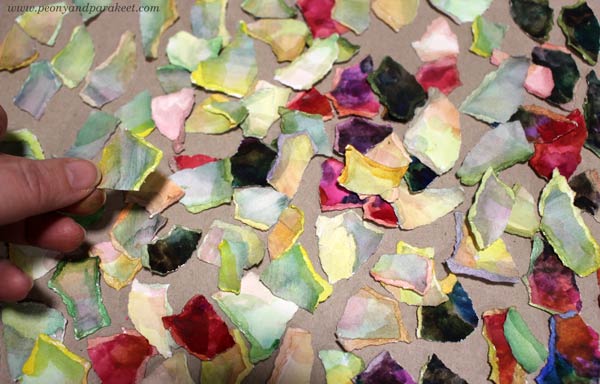
You can also spread the paint partly over the piece so that the color transition is less dramatic and the piece gets more depth. Some of my pieces have more colorful and some more blended edges. Variation is always good!
Step 4 – Glue the Pieces
Pick a blank background paper and glue the pieces on it. My background is fairly small, about 6 x 8 inches. I use Towbow Aqua Liquid Glue. It’s not perfect because it’s a bit brittle when it dries, but I like it because it doesn’t make my fingers sticky.
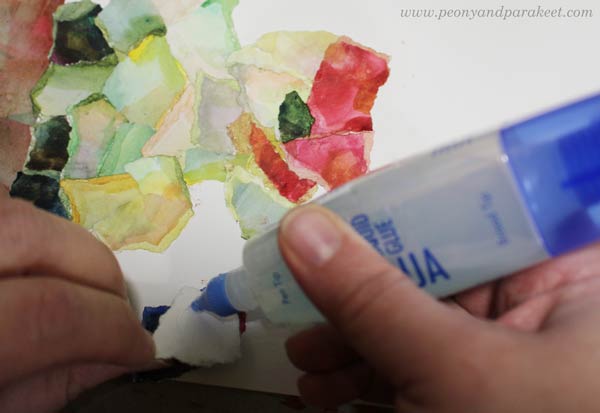
Start from one edge and work towards the center. Save most of the brights for the center and keep the edges less colorful. Create clusters and look for happy accidents.
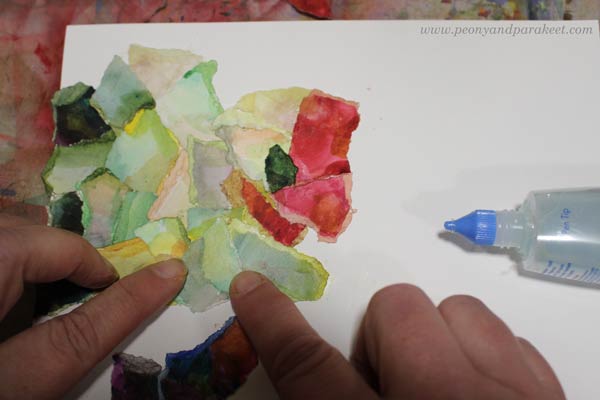
While creating, think about this!
Papers that have been destroyed now get a new beginning. It’s like a window has been shattered and a new stained glass one gives a new view. Always when you create is some kind of distortion. But that’s not a bad thing at alll. We need these new views to make a shift in our lives, to see beyond the obvious.
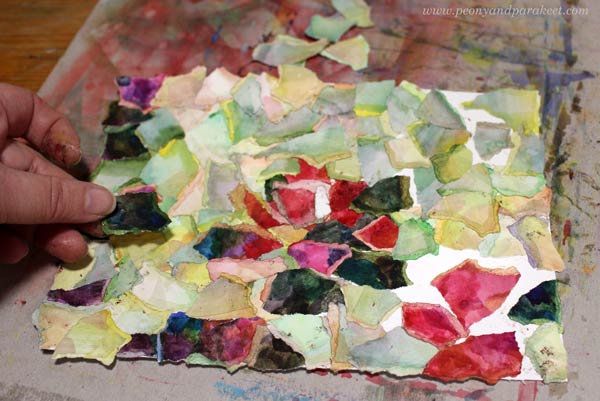
Notice, that you can leave the background partly visible here and there.
Step 5 – Finish with Watercolor
You can still adjust the collage by painting over the pieces.
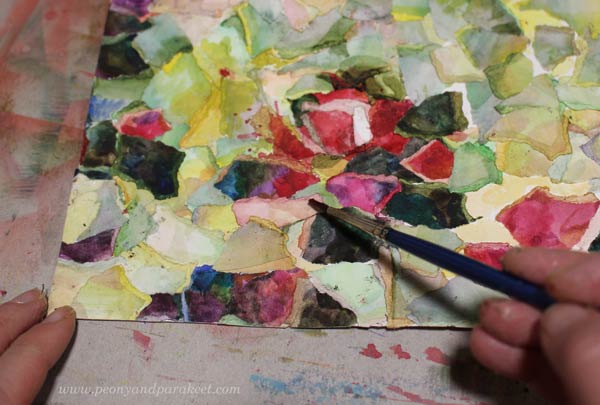
You can add details, but more than that I would recommend adding a thin color layer on most of the pieces so that you get a more unified look. I added yellow over most of the pale greens, and also to the areas where I left the blank paper visible. I like to have white as a highlight color only, and not everywhere.
While creating, do this!
Take a break! Don’t try to do everything in one sitting. Rest and give your mind some time to process what you have been doing!

The collage is now finished, but the process is not. So, proceed to the next step!
Step 6 – Explore Your Torn Paper Collage
Take photos of your torn paper collage. Don’t just take the realistic photo to your archive but get creative! Think about the light and the air and how they create a new layer to everything we see. Take the collage to a place where you get strong sunlight and dark shadows to get a new puzzle over it.
Or if you have a DSLR camera, do what I did: take the collage to a dark room, legthen the exposure so that taking the photo lasts many seconds. Then move the flashlight around the picture and its surroundings.

With the long exposure, you can also move the collage around to get an artistic photo.
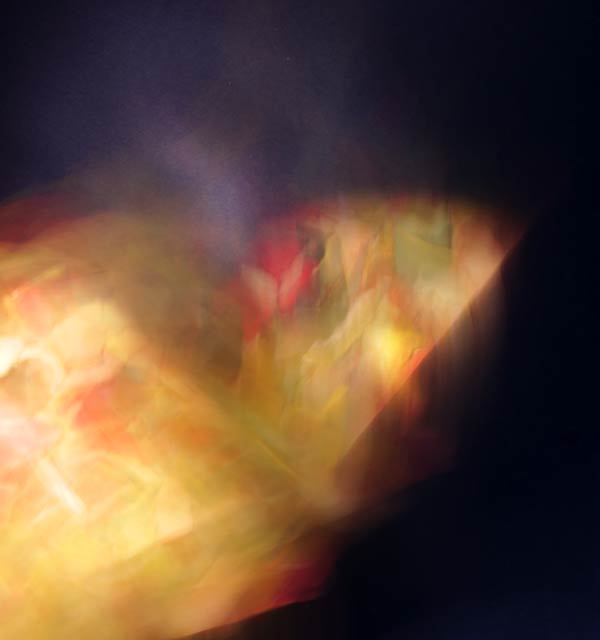
You can start with a blank paper, but end up with painting with light.
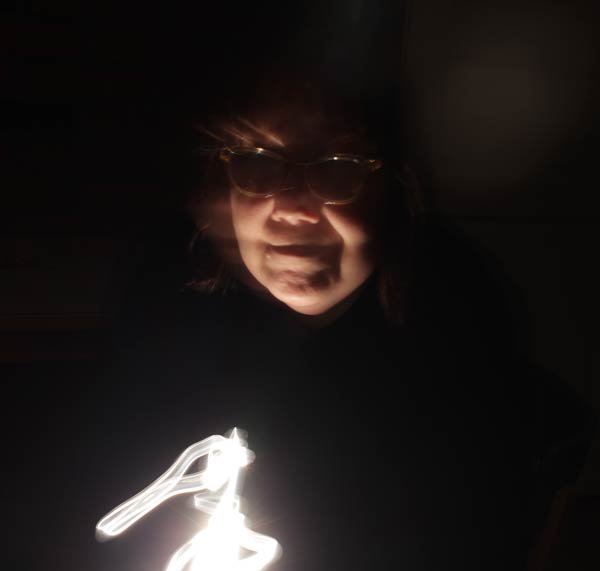
Creating art is not only about mastering techniques or imagining things. Artistic exploration is where freely practice both.
Torn Paper Collage – Where Did This Idea Come From?
The oil painting that I am currently working on, is influenced by my artistic explorations. And, it’s also vice versa. When I looked at the painting that is still in progress, I felt the need to tear some paper, and so the torn paper collage was born.
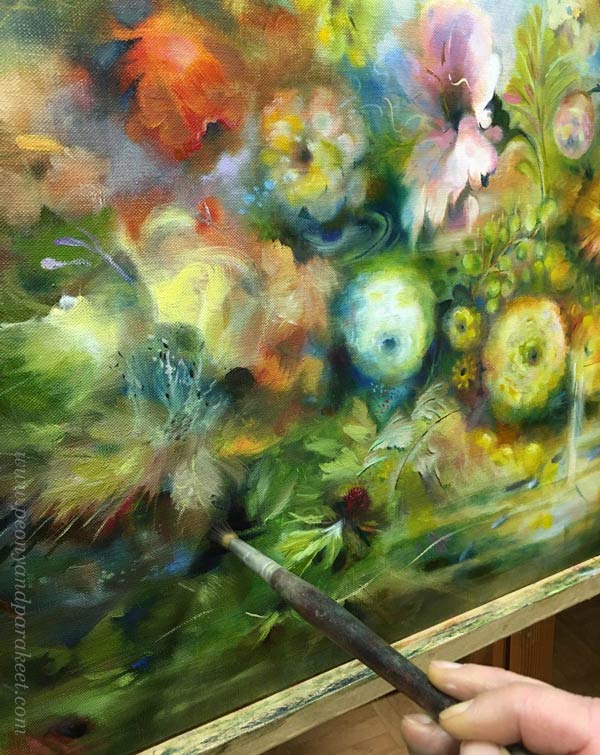
I like to explore movement, so moving the collage under the camera produced an image that is related to this painting. That photo will inspire me when I am adding finishing touches to the painting.
I believe we have to explore to move forward in the path.
What do you think?
About Birds and Art
This week is about observing birds and bringing them into our art.
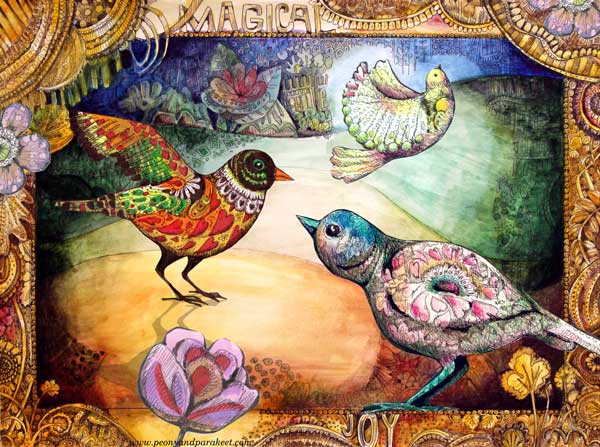
These are from my online classes Animal Inkdom and Magical Inkdom.
Let’s start with a lonely budgie.
Last fall, the same sight always awaited me in the mornings – a lonely budgie in a big cage. The door was open, and I turned on the full-spectrum bird lamp, but nothing cheered her up. Ever since Primavera’s husband Leonardo had died unexpectedly, her world had been empty, and even the best YouTube budgies couldn’t fill it.
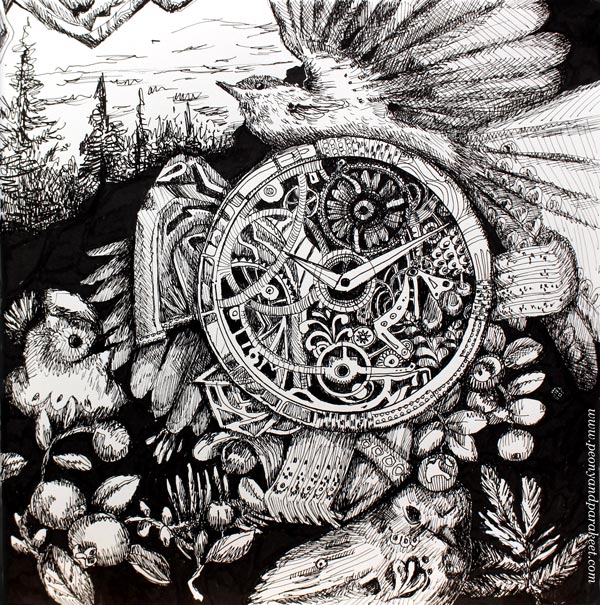
I have had budgies since 1991. My first budgie, Piuku, was also alone at first. Unlike 5-year-old Primavera, Piuku was a young bird. She adapted to being alone by taking me as her best friend. Later on, Piuku got other birds as companions.
Birds Bring Joy

The most enviable quality of birds is their ability to fly, but the more you get to know birds, the more you realize that their social life is very lively. A small flock of a few budgies can be like a soap opera. There will be arguments, gusts of affection, gossip, singing sessions, and all kinds of fun play. This way, the day flies by!
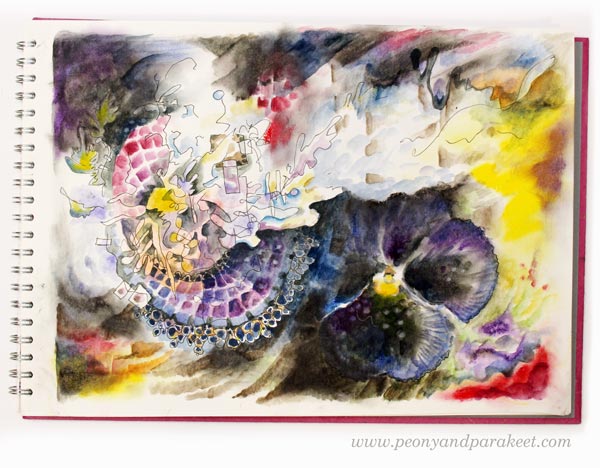
I have admired birds since swallows made their nest in the eaves of my childhood home. There were many other birds in the big yard too. I had bird books, and I dreamed about seeing kingfishers and other exotic birds.
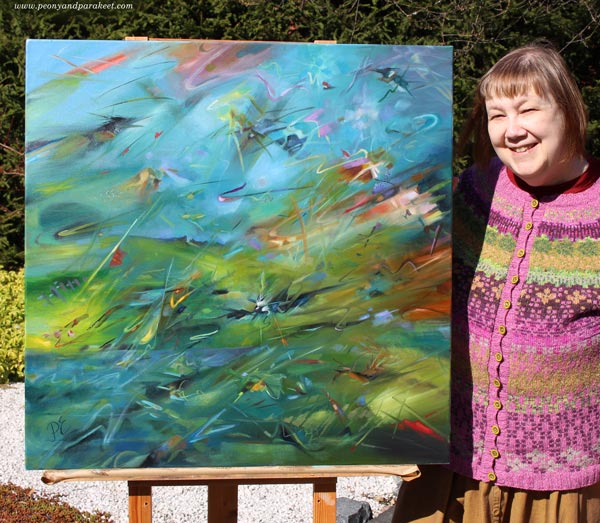
Similarly, as wild birds make you look up, pet birds bring lightness to the home. Their vocals are clear and the flight sounds lighten the atmosphere. It is as if the world is not only lying down but also up in the air.
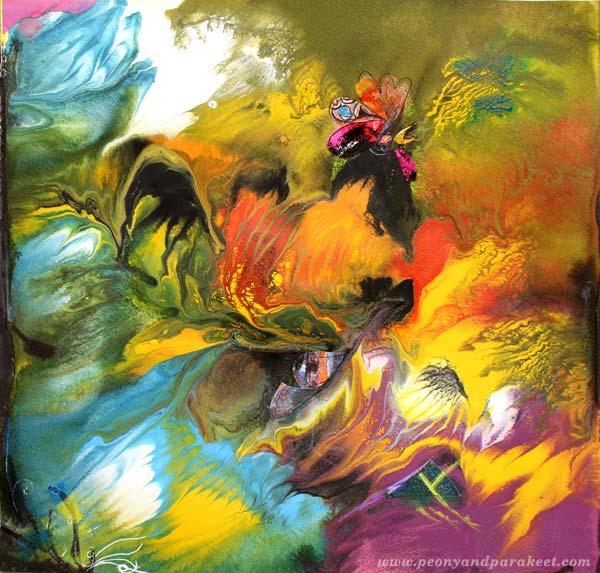
Birds and Flowers
At the beginning of my entrepreneurial career in 2008, I founded an Etsy shop to sell crafts and named it Kukkilintu.

Kukkilintu is a Karelian embroidered bird pattern that symbolizes happiness.
Karelia is a place in Eastern Finland, a part of it was lost in the war with Russia in 1940. I live in Southern Finland but was born in Northern Karelia.
Karelian people believed that the soul leaves the body in the form of a bird. Kukkilintu is a bit like the Finnish version of the peacock, which appears in the designs of other countries with the same meaning.
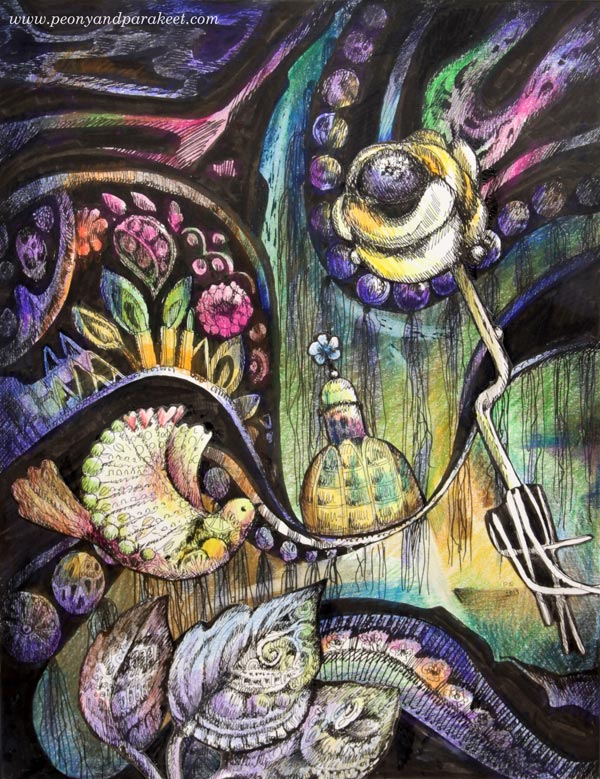
I thought the name “kukkilintu” was funny because it had the words “kukka” and “lintu” – “flower” and “bird.” When I was thinking about a name for my art blog a couple of years later in 2010, I thought that the flower could be a peony and the bird a budgie, so, a parakeet.

These two themes “flower” and “bird” have guided my creative process. I have wanted to learn the language of flowers and create beauty in the world, but also understand the life of birds and include their movement. Birds, flowers, and art belong together.
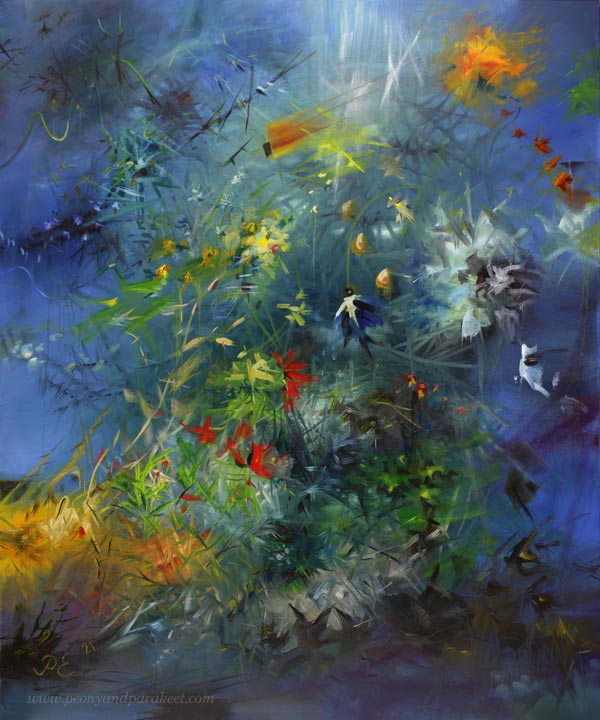
However, recently in my everyday life, it happened that the more I delved into the flowers, the more time they took away from the birds. I didn’t want to keep pet birds anymore, but felt that watching wild birds would be enough.
Magical Scene
Outdoors, one scene is above the rest – when a bird flies across the scenery. The bird then becomes kukkilintu – a flower bird. It takes over the landscape and erases all the sadness.

I came up with this when I was grieving the death of one of my dogs. Since then this very ordinary event has made me happy. It’s a message from the world that we always have inside of us, but that we don’t always remember, especially when we’re like a lonely budgie that has a hard time seeing ahead in life.
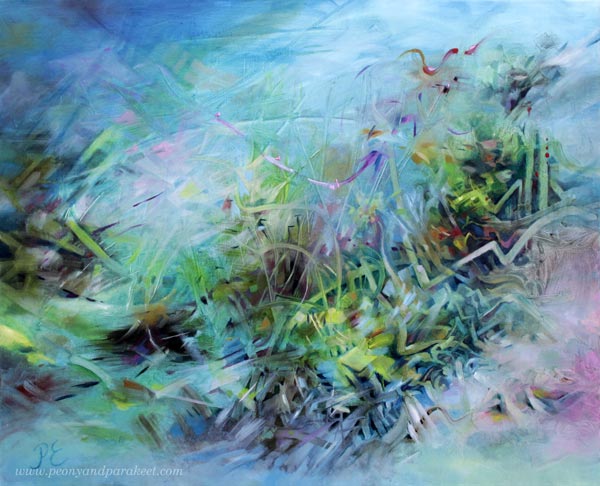
We must believe in our abilities, and happy endings as well. I found a new home for Primavera, where it has a spouse who was also widowed. I wish Primavera a long life. After all, it already has a long-lived name-sake, the famous painting by Botticelli born in the 15th century, which I have been to Florence to admire.
Do birds appear in your art?
Beautiful Blog Post
This week is about creating beauty, and I have a beautiful blog post for you.
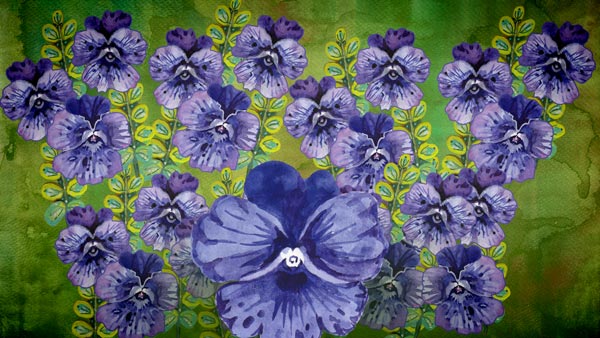
Violets on an Adventure
Ten years ago, an old yard tiling gave us a surprise. Renovating it had been on our to-do list, but there had been other things to do in the house. But we were lucky.
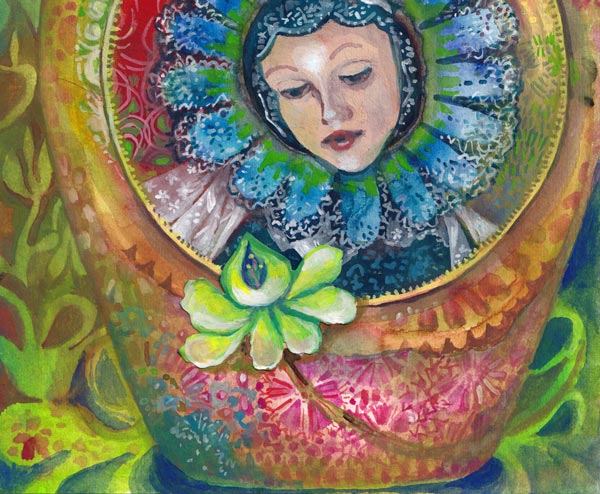
The violets planted in the pot had looked at the tiling and its gaps with completely different eyes. What an opportunity for seeds! So, the following year, we were able to enjoy the glory of flowers in the surprising place.
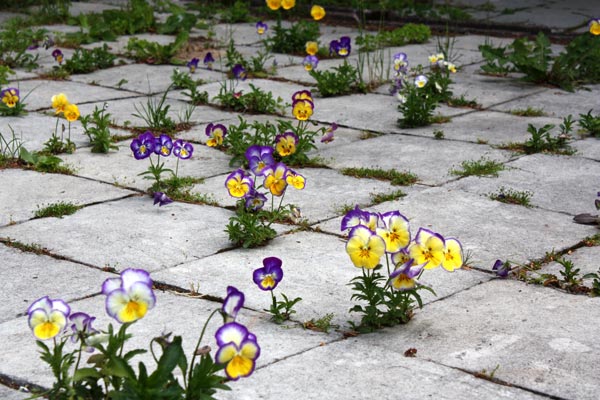
Creativity is a flower that wants to break free from its pot and get on an adventure. Abundance is allowed and ugliness can enable beauty.
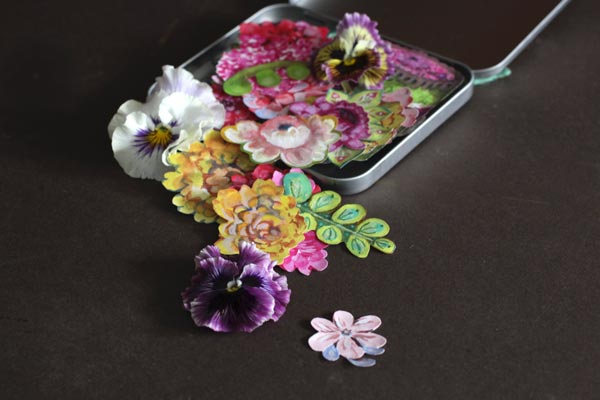
A painting that starts with a few ugly brushstrokes can be decorated
to rich and beautiful.
Beautiful Decodashery
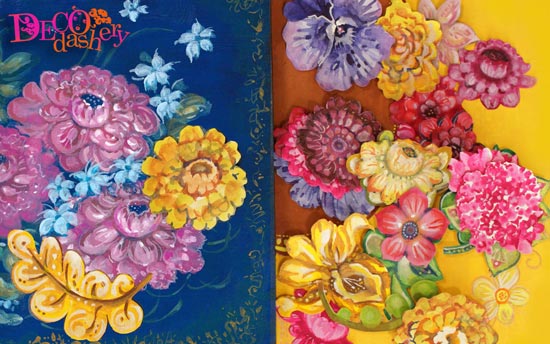
My online class Decodashery is about creating beauty that easily finds its purpose. This kind of art is not just fun to make but perfect for cards and gifts.
Decodashery is one of my personal favorites. The videos are inspiringly colorful and uplifting. You play with the tradition of decorative art and create beauty that people have always found attractive. >> Buy here!